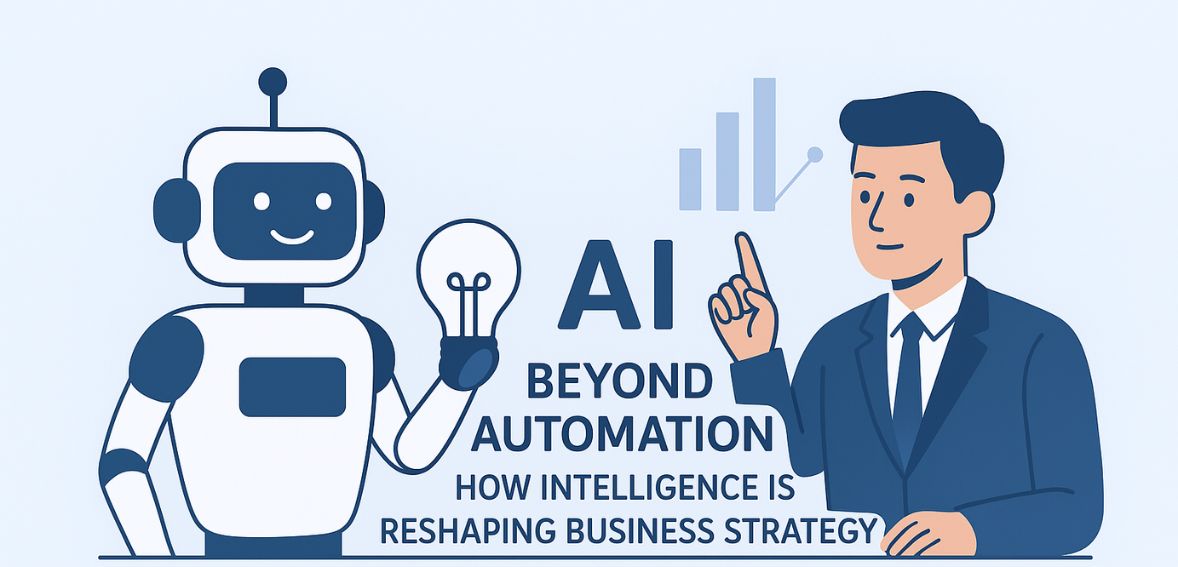
AI Beyond Automation: How Intelligence Is Reshaping Business Strategy
Artificial intelligence (AI) has advanced far beyond automating repetitive tasks in recent years. Automation, which began as the use of bots to replace repetitive tasks, has developed into a key tool for business transformation. Businesses that previously used AI to reduce expenses are now posing more profound questions, such as how intelligence might change our competitive advantage, business model, and mission.
The change is significant. By anticipating problems, enabling new capabilities, and redesigning workflows that rival the best human judgment, intelligence is about doing things differently rather than just faster.
Ignoring this change means missing a strategy in addition to savings for businesses of all sizes. This article explores how artificial intelligence (AI) is changing business strategy, why it matters more than automation, how businesses can strategically implement it, potential pitfalls to be aware of, and future directions.
Reimagining Strategy: From Efficiency to Agility

Cost leadership, differentiation, and focus were the three main pillars upon which business strategy was traditionally built. Businesses looked to gain a competitive edge by providing something unique or by doing more with less. But strategy is changing in the era of intelligence. Rather than just improving efficiency, AI helps companies stay nimble, informed, and quick to adapt.
Forward-thinking businesses treat AI as a component of the strategic fabric—how value is captured, how products are developed, and how customers are served—rather than as a tool tucked into operations. Companies can now spot shifts in demand and tweak their products almost instantly.
Strategy shifts from five-year plans to ongoing evolution driven by insights. It allows businesses to stop reacting to change and start shaping it themselves.
Intelligence Embedded Across the Value Chain
Businesses start integrating intelligence throughout the value chain when they go beyond utilizing AI for discrete tasks. Before making a tangible investment, AI in R&D can identify new needs, create new product concepts, and simulate results.
Predictive analytics and anomaly detection improve resilience, optimize scheduling, and cut waste in the supply chain and operations. Hyper-personalization, dynamic pricing, and predictive churn models are beneficial to marketing and sales. Continuous forecasting, talent optimization, and risk management are examples of how back-office operations like finance and HR are also changing.
In short, intelligence becomes more than just a convenience. Businesses that integrate AI end-to-end gain significantly more strategic value than those that treat it as a point solution, according to a recent industry study. Intelligence embedded deep and widely allows a business to sense, decide, and act faster — and differently.
Why Many Companies Struggle to Capture Value
Even with the promise, there is still a significant disconnect between investment and results. Only a small percentage of organizations realize quantifiable value from their AI programs, according to reports from top consultancies.
Data fragmentation, a lack of strategy, unclear ownership, governance problems, and a shortage of workforce skills are common obstacles. AI cannot be successful with just a few predictive models or chatbots. It necessitates rigorous performance measurement, end-to-end process integration, and alignment with business purpose.
Businesses frequently fall short when they view intelligence as a fancy cost-cutting tool instead of a strategic asset. Moving from experimentation to implementation—including AI into decision-making processes, accountability frameworks, and workflows—is the difficult part.
Redefining the Decision-Making Paradigm
Making decisions is one of the most significant changes that AI has brought about. Businesses now incorporate predictive and prescriptive analytics into strategic discussions rather than depending solely on human intuition. AI models simulate situations, find patterns in large data sets, and suggest courses of action.
In reality, this results in quicker, more fact-based, and frequently counterintuitive decisions. Think about how a manufacturer might optimize asset maintenance schedules using machine learning models—not because a human would, but because the data requires it.
Or how a retailer might instantly modify assortments and prices in response to changing demand signals. To ensure that the insight-to-action loop functions effectively, executives now orchestrate human-machine collaboration rather than acting as the sole decision-maker.
Workforce & Leadership in the Age of Intelligence

Organizations need to reconsider their workforce and leadership models as AI becomes more strategic. Talent now includes both human and machine capabilities rather than just human skills. Leaders need to know where machines provide speed and scale and where human judgment adds value.
They need to foster an environment where learning never stops, try new things all the time, and accept failure as a necessary part of growth. Successful organizations make significant investments in skills, change management, and governance.
These investments include rewriting roles, integrating AI literacy, training staff, and developing new career paths centered on hybrid work. The most prosperous businesses approach intelligence transformation with as much consideration for people as for technology.
Data & Technology Foundations: The Strategic Bedrock
Every strategic AI project has infrastructure, architecture, and data at its core. Reliable and responsible performance of models is made possible by high-quality, well-governed data. Because data is still fragmented, inconsistent, or unreliable, many businesses make mistakes.
Integrated data platforms, modern cloud architecture, APIs, scalable infrastructure, and robust security and ethical frameworks are all necessary for intelligence. AI is still tactical without this basis. It turns AI into a strategic tool that opens up new business models, deeper insights, and quicker cycles. Without data, strategy is guesswork, and without a foundation, intelligence is a waste of money.
As explored in building the digital foundations of modern business, this interconnected structure enables companies to turn fragmented systems into unified strategic ecosystems.
Business Models Reimagined
The way intelligence makes new business models possible is arguably the most exciting frontier. AI fosters the growth of subscription-as-a-service, outcome-based models, platform-driven ecosystems, and ongoing revenue. Businesses are able to track usage, forecast loss of talent, customize their products, and even try out entirely new revenue-generating strategies.
Businesses can now engage continuously, offer dynamic pricing, and innovate their services without being constrained by one-time transactions thanks to intelligence. Businesses in industries as varied as consumer software and industrial equipment, for instance, now sell “performance outcomes” rather than physical products, relying on AI and embedded sensors to ensure uptime, efficiency, or customer satisfaction.
Price-minus-cost is no longer the formula for strategy; instead, it is now price-plus-predictive-value-plus-experience.
Risk, Ethics, and Responsible Intelligence

Great power carries responsibility. There are numerous ethical, legal, and reputational hazards as AI expands into strategic areas. Strategic hazards include model bias, privacy violations, a lack of transparency, concerns about job displacement, and systemic errors.
Regulators and stakeholders increasingly expect firms to behave responsibly—embedding fairness, accountability, and transparency into AI systems. Without trust, intelligence is meaningless. Organizations need to develop governance frameworks that include explainability, model risk assessments, audit trails, and bias mitigation.
AI errors can cost more than just money; they can also cost a company’s mission and reputation. Doing the right thing while being smart is what is meant by strategic intelligence.
Change Management and Cultural Transformation
Strategy does not shift simply by buying new tools. Transforming into an intelligence-driven enterprise requires cultural change. Leaders must redefine success metrics, redesign incentives, align processes, and elevate digital literacy. Organizations must foster curiosity, experimentation, and resilience.
They must accept that some initiatives will fail fast, learn, and pivot. Employees must feel enabled rather than replaced. Trust must be built between humans and machines, and hybrid teams must learn to collaborate. In many firms, the bigger barrier isn’t technology — it’s the human element: mindset, governance, and design. Intelligence becomes strategic when a business reimagines how it works.
Technology and automation in pricing are revolutionizing how businesses test, iterate, and scale their approach. To explore strategies that help boost productivity with AI across workflows and teams, refer to this insight.
Scaling Intelligence: From Pilots to Production
Too many firms experiment with AI in pilot mode without scaling. Strategy fails when proof-of-concepts don’t translate into business impact. Scaling intelligence means embedding models into every workflow, aligning KPIs, building change plans, monitoring metrics, and iterating.
It means putting AI in the hands of operational teams rather than confining it to the innovation lab. Organizations must balance speed with rigor: iterate often, measure outcomes, retire pilots, transfer ownership, and build feedback loops. Intelligence at scale becomes sustainable only when leaders make it part of business-as-usual — not a separate innovation silo.
Sustaining Long-Term Intelligence Value
AI scaling is just the first step; the true difficulty lies in maintaining it. Models deteriorate over time as consumer behavior changes and data patterns change. To retain value, businesses need to implement lifecycle management, performance monitoring, and ongoing retraining.
Teams in charge of strategic governance should routinely assess the model’s results, equity, and fit with business objectives. The strength of AI is not in its initial genius but rather in its accuracy and relevance over time. A culture of improvement and iteration guarantees that intelligence systems stay current rather than becoming outdated.
Businesses that approach artificial intelligence (AI) as a living ecosystem rather than a one-time installation increase their ability to withstand disruptions and guarantee that intelligence will continue to support their long-term strategic goals.
Human-AI Collaboration as Competitive Edge

When humans and machines work together seamlessly, true transformation takes place. Humans contribute context, ethics, and empathy, while AI offers analytical precision. The most successful companies establish cross-functional teams in which decision-makers, data scientists, and domain experts collaborate.
By bridging the gap between insight and action, this integration turns predictions into significant outcomes. For example, an AI model learns from feedback to get better over time, and a logistics planner can use local knowledge to improve AI-generated routes.
This kind of cooperation speeds up decision-making and increases technological trust. Innovation and productivity both rise when workers view AI as a collaborator rather than a threat. Human-machine synergy turns into a fundamental strategic advantage rather than a futuristic idea.
Customer-Centric Intelligence

Deepening customer understanding is where AI has the most promise. Intelligence systems reveal intent, emotion, and future behavior in addition to demographic segmentation. Businesses can anticipate needs before customers express them thanks to predictive analytics.
Transactions become relationships due to this proactive insight. For instance, a bank can provide dynamic credit solutions that align with customer behavior, while a retailer can tailor promotions based on browsing and purchase history. Brand loyalty is redefined by the move from reactive to predictive service.
Instead of being watched, customers feel appreciated and seen. Transparency and privacy protection are necessary to strike this balance, but when implemented properly, AI not only enhances service but also serves as the cornerstone of long-lasting trust.
Measuring Strategic Impact
Measuring AI’s strategic impact involves more than just monitoring automation efficiency or productivity increases. Knowing how intelligence changes competitive advantage, customer experience, and decision-making is the key to true measurement. Companies need to evaluate whether AI efforts are promoting quicker operations, sustainable growth, and more intelligent risk management.
Reduced time-to-insight, increased forecast accuracy, and quantifiable returns from personalized or predictive strategies are important indicators. Qualitative indicators, such as staff flexibility, innovation culture, and confidence in data-driven systems, are equally important, though. The most successful businesses view AI as a living ecosystem and assess results rather than just outputs. AI transforms from a cost center to a catalyst for long-term change when measurement links advancements in technology to observable strategic value.
The Future Landscape: What Comes Next
Intelligence will continue to revolutionize business in the future. Large-scale creativity will be made possible by generative AI, decision intelligence will enter real-time control loops, continuous learning systems will be able to adapt on their own, and data-driven platforms will serve as the foundation for business ecosystems.
Businesses will compete more on insight-enabled experiences than on product features. Human-machine cooperation will develop into orchestration. Instead of being top-down and periodic, strategy will become dynamic, subtle, and continuous. Companies that adapt will take the lead; those that remain inflexible will be disrupted.
Conclusion
Artificial intelligence is now more than just an automation tool. It now plays a strategic role in determining how businesses compete, add value, and look to the future. Redefining strategy, integrating technology and data throughout the organization, reevaluating the workforce and leadership, and creating business models that capitalize on new sources of value are all part of embracing intelligence.
Few organizations are successful, so the challenge is real, but the opportunity is revolutionary. When used effectively, artificial intelligence (AI) transforms things into something new, intelligent, and resilient rather than just making them faster or less expensive. Intelligence is now a must in the race to the future. It is necessary.